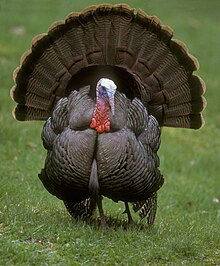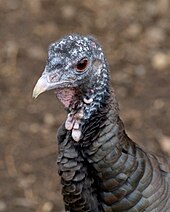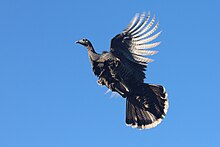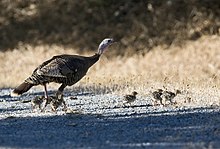| Wild turkey | |
|---|---|
 | |
| Male (tom) wild turkey displaying | |
| Scientific classification | |
| Kingdom: | Animalia |
| Phylum: | Chordata |
| Class: | Aves |
| Order: | Galliformes |
| Family: | Phasianidae |
| Genus: | Meleagris |
| Species: | M. gallopavo |
| Binomial name | |
| Meleagris gallopavo Linnaeus, 1758 | |
| Subspecies | |
6, see text
| |
 | |
| Distribution of M. gallopavo | |
The wild turkey (Meleagris gallopavo) is an upland ground bird native to North America and is the heaviest member of the diverse Galliformes. It is the same species as the domestic turkey, which was originally derived from a southern Mexican subspecies of wild turkey (not the related ocellated turkey). Although native to North America, the turkey probably got its name from the domesticated variety being imported to Britain in ships coming from the Levant via Spain. The British at the time therefore associated the wild turkey with the country Turkey and the name prevails.
Description
Adult wild turkeys have long reddish-yellow to grayish-green legs. The body feathers are generally blackish and dark, sometimes grey brown overall with a coppery sheen that becomes more complex in adult males. Adult males, called toms or gobblers, have a large, featherless, reddish head, red throat, and red wattles on the throat and neck. The head has fleshy growths called caruncles. Juvenile males are called jakes; the difference between an adult male and a juvenile is that the jake has a very short beard and his tail fan has longer feathers in the middle. The adult male's tail fan feathers will be all the same length.[5]When males are excited, a fleshy flap on the bill expands, and this, the wattles and the bare skin of the head and neck all become engorged with blood, almost concealing the eyes and bill. The long fleshy object over a male's beak is called a snood. Each foot has three toes in front, with a shorter, rear-facing toe in back; males have a spur behind each of their lower legs.[6]
...
Habitat[edit]
Wild turkeys prefer hardwood and mixed conifer-hardwood forests with scattered openings such as pastures, fields, orchards and seasonal marshes. They seemingly can adapt to virtually any dense native plant community as long as coverage and openings are widely available. Open, mature forest with a variety of interspersion of tree species appear to be preferred. In the Northeast of North America, turkeys are most profuse in hardwood timber of oak-hickory (Quercus-Carya) and forests of red oak (Quercus rubra), beech (Fagus grandifolia), cherry (Prunus serotina) and white ash (Fraxinus americana). Best ranges for turkeys in the Coastal Plain and Piedmont sections have an interspersion of clearings, farms, and plantations with preferred habitat along principal rivers and in cypress (Taxodium distichum) and tupelo (Nyssa sylvatica) swamps. In Appalachian and Cumberland plateaus, birds occupy mixed forest of oaks and pines on southern and western slopes, also hickory with diverse understories. Bald cypress and sweet gum (Liquidambar styraciflua) swamps of s. Florida; also hardwood of Cliftonia (a heath) and oak in north-central Florida. Lykes Fisheating Creek area of s. Florida has up to 51% cypress, 12% hardwood hammocks, 17% glades of short grasses with isolated live oak (Quercus virginiana); nesting in neighboring prairies. Original habitat here was mainly longleaf pine (Pinus palustris) with turkey oak (Quercus laevis) and slash pine (Pinus caribaea) "flatwoods," now mainly replaced by slash pine plantations.
Behavior
Flight
Despite their weight, wild turkeys, unlike their domesticated counterparts, are agile fliers. In ideal habitat of open woodland or wooded grasslands,[19] they may fly beneath the canopy top and find perches. They usually fly close to the ground for no more than 400 m (a quarter mile).
Vocalizations[edit]
Turkeys have many vocalizations: "gobbles", "clucks", "putts", "purrs", "yelps", "cutts", "whines", "cackles", and "kee-kees". In early spring, males older than 1-year-old (sometimes called gobblers or toms) and, occasionally to a lesser extent, males younger than 1-year-old (sometimes called jakes) gobble to announce their presence to females and competing males. The gobble can carry for up to a mile. Males also emit a low-pitched "drumming" sound; produced by the movement of air in the air sack in the chest, similar to the booming of a prairie chicken. In addition they produce a sound known as the "spit" which is a sharp expulsion of air from this air sack. Hens "yelp" to let gobblers know their location. Gobblers often yelp in the manner of females, and hens can gobble, though they rarely do so. Immature males, called jakes, often yelp.
Foraging[edit]
Wild turkeys are omnivorous, foraging on the ground or climbing shrubs and small trees to feed. They prefer eating acorns, nuts and other hard mast of various trees, including hazel, chestnut, hickory, and pinyon pine as well as various seeds, berries such as juniperand bearberry, roots and insects. Turkeys also occasionally consume amphibians and small reptiles such as lizards and snakes. Poults have been observed eating insects, berries, and seeds. Wild turkeys often feed in cow pastures, sometimes visit back yard bird feeders, and favor croplands after harvest to scavenge seeds on the ground. Turkeys are also known to eat a wide variety of grasses.
Turkey populations can reach large numbers in small areas because of their ability to forage for different types of food. Early morning and late afternoon are the desired times for eating.
Social structure and mating
Males are polygamous, mating with as many hens as they can. Male wild turkeys display for females by puffing out their feathers, spreading out their tails and dragging their wings. This behavior is most commonly referred to as strutting. Their heads and necks are colored brilliantly with red, blue and white. The color can change with the turkey's mood, with a solid white head and neck being the most excited. They use gobbling, drumming/booming and spitting as signs of social dominance, and to attract females. Courtship begins during the months of March and April, which is when turkeys are still flocked together in winter areas.
Males may be seen courting in groups, often with the dominant male gobbling, spreading their tail feathers (strutting), drumming/booming and spitting. In a study, the average dominant male that courted as part of a pair of males fathered six more eggs than males that courted alone. Genetic analysis of pairs of males courting together shows that they are close relatives, with half of their genetic material being identical. The theory behind the team-courtship is that the less dominant male would have a greater chance of passing along shared genetic material than if it were courting alone.[20]
When mating is finished, females search for nest sites. Nests are shallow dirt depressions engulfed with woody vegetation. Hens lay a clutch of 10–14 eggs, usually one per day. The eggs are incubated for at least 28 days. The poults are precocial and nidifugous, leaving the nest in about 12–24 hours.
...
Benjamin Franklin and the U.S. national bird suggestion
The idea that Benjamin Franklin preferred the turkey as the national bird of the United States comes from a letter he wrote to his daughter Sarah Bache on January 26, 1784.[58]The main subject of the letter is a criticism of the Society of the Cincinnati, which he likened to a chivalric order, which contradicted the ideals of the newly founded American republic.[59]
In one section of the letter, Franklin remarked on the appearance of the bald eagle on the Society's crest:
In one section of the letter, Franklin remarked on the appearance of the bald eagle on the Society's crest:
“
|
Others object to the Bald Eagle, as looking too much like a Dindon, or Turkey. For my own part I wish the Bald Eagle had not been chosen the Representative of our Country. He is a Bird of bad moral Character. He does not get his Living honestly. You may have seen him perched on some dead Tree near the River, where, too lazy to fish for himself, he watches the Labour of the Fishing Hawk [osprey]; and when that diligent Bird has at length taken a Fish, and is bearing it to his Nest for the Support of his Mate and young Ones, the Bald Eagle pursues him and takes it from him.
With all this Injustice, he is never in good Case but like those among Men who live by Sharping & Robbing he is generally poor and often very lousy. Besides he is a rank Coward: The little King Bird not bigger than a Sparrow attacks him boldly and drives him out of the District. He is therefore by no means a proper Emblem for the brave and honest Cincinnati of America who have driven all the King birds from our Country... I am on this account not displeased that the Figure is not known as a Bald Eagle, but looks more like a Turkey. For in Truth the Turkey is in Comparison a much more respectable Bird, and withal a true original Native of America... He is besides, though a little vain & silly, a Bird of Courage, and would not hesitate to attack a Grenadier of the British Guards who should presume to invade his Farm Yard with a red Coat on.
|









No comments:
Post a Comment